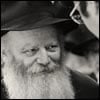The Rebbe would often go to the Ohel, the resting place of his father-in-law, Rabbi Yosef Yitzchak Schneersohn (the "Rayatz"), of righteous memory. In the first year after the Rayatz's passing in 1950, the Rebbe would take a bus to the Ohel together with the yeshivah students before every Rosh Chodesh (the first day of a new Jewish month). After that year, the Rebbe would travel by car. After the Rebbe's mother passed away in 1964, the Rebbe started going an additional time, mid-month. In even later years, there were times when the Rebbe would go to the Ohel four times a week, nearly every weekday.
I drove the Rebbe almost every time, thousands of times. The Rebbe always had bags of letters with him, filled with requests of every kind that the Rebbe would read at his father-in-law's resting place.

The Rebbe stood opposite Rabbi Yosef Yitzchak's burial spot the entire time. There was a small room built to protect the Rebbe from the cold, heat, snow and rain. In the summertime, we had an air conditioner, and in the wintertime a heater, so the Rebbe would remain relatively comfortable.
The custom at the Ohel is to tear your letter after reading it, and toss the shreds onto the burial spot. The Rebbe would do this with many of the letters he received. Sometimes, however, the Rebbe would jot a response on a letter and bring it back with him to his office.
I had a telephone in the car, an entire mobile unit. Sometimes, at the Ohel, the Rebbe would tell me about something that needed to be taken care of immediately or instruct me to call the office in Brooklyn. There was much communication between the Rebbe and myself throughout the time at the Ohel.
The Rebbe was generally non-demonstrative, as was the case during prayers which he spoke quietly and serenely. The Rebbe's behavior at the Ohel was essentially the same.
Before leaving the Ohel, the Rebbe would circle the burial site, sometimes once, twice, or seven times.
During our drives to the Ohel and back, the Rebbe and I had many conversations, often catching up on important matters.
The last time I drove the Rebbe to the Ohel, the day he had a stroke, he spoke more than usual. He said many interesting things I am not at liberty to share, but which, retrospectively, I find quite momentous.
On Monday, March 2, 1992, at 5:20 p.m., the Rebbe became ill while standing at the Ohel. I tried to communicate with the Rebbe, but he was unresponsive. I understood what had happened; I've seen stroke victims before. We were in the cemetery alone and I knew that the situation was extremely serious. I immediately called the main office at 770 and told them to send Hatzolah, the volunteer ambulance service.
Unfortunately, things didn't move fast enough; they could not get their ambulance through the cemetery's narrow paths. And then, as they were trying, the battery of their vehicle died. It was terrible.
Finally, after an hour and a half, another ambulance arrived.
The Rebbe never spoke again.
Exactly two years later, the Rebbe's condition deteriorated and he was hospitalized in Beth Israel Medical Center in Manhattan. After Shabbat, on the third of Tammuz, 1994, I stood next to the Rebbe's bed with three other people when, at 1:50 a.m., the Rebbe, of righteous memory, returned his soul to the Creator.






